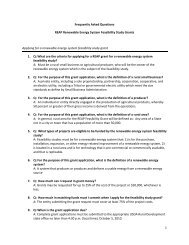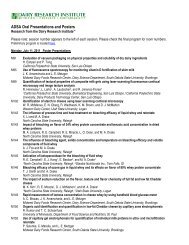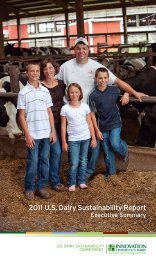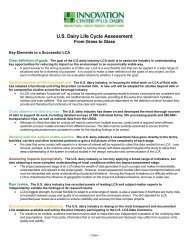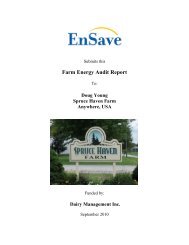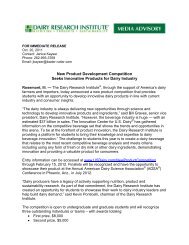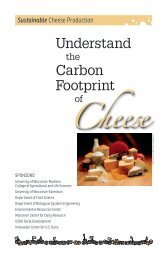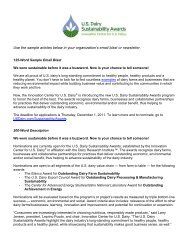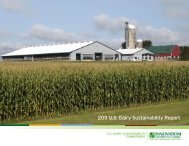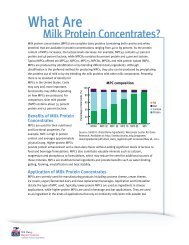Processor Handbook - Innovation Center for US Dairy
Processor Handbook - Innovation Center for US Dairy
Processor Handbook - Innovation Center for US Dairy
Create successful ePaper yourself
Turn your PDF publications into a flip-book with our unique Google optimized e-Paper software.
5. Definitions<br />
Total water discharge: It is the sum of water effluents<br />
discharged over the course of the reporting period to<br />
subsurface waters, surface waters, sewers that lead to<br />
rivers, oceans, lakes, wetlands, treatment facilities, and<br />
ground water either through:<br />
• A defined discharge point (point source discharge);<br />
• Over land in a dispersed or undefined manner<br />
(nonpoint source discharge); or<br />
• Wastewater removed from the reporting<br />
organization via truck. Discharge of collected<br />
rainwater and domestic sewage is not regarded as<br />
water discharge.<br />
Wastewater-to-milk processed ratio: It is the efficiency of<br />
wastewater discharged per unit of milk processed or dairy<br />
product output by the company. It can<br />
be used to assess efficiency within the<br />
company over several time intervals; it<br />
should not be used to benchmark against<br />
different companies.<br />
6. Documentation<br />
In<strong>for</strong>mation sources about the volume<br />
of water discharged by the reporting<br />
organization include flow meters (pointsource<br />
discharges or when discharges are<br />
released through a pipe) and regulatory<br />
permits. (GRI G3.1)<br />
7. Resources<br />
• U.S. EPA, Water Quality Standards<br />
<strong>Handbook</strong>: Second Edition, www.<br />
water.epa.gov/scitech/swguidance/<br />
standards/handbook/index.cfm.<br />
• Stockholm Convention on Persistent<br />
Organic Pollutants (POPs), 2001, www.chm.pops.int/<br />
Home/tabid/2121/mctl/ViewDetails/EventModID/871/<br />
EventID/230/xmid/6921/Default.aspx.<br />
Potentially to add to this set of indicators in future<br />
versions of the Guide: CROSS-MEDIA Economic indicator:<br />
Report the annual cost of water disposal and, if applicable,<br />
costs reductions and savings from new practices,<br />
technologies or other reasons.<br />
Water Recycling and Reuse —<br />
Secondary PM Water 4<br />
Water Recycled<br />
1. Relevance<br />
Reporting the total volume of water recycled contributes<br />
to an understanding of the overall scale of avoided impacts<br />
and risks associated with the company’s water use. The total<br />
volume recycled provides an indication of the company’s<br />
relative size and importance as a recycler of water, and<br />
provides a baseline figure <strong>for</strong> other calculations relating to<br />
recycling efficiency and water reuse.<br />
The systematic ef<strong>for</strong>t to monitor and improve the efficient<br />
reuse of water in the company is directly linked to<br />
water consumption costs. Clean freshwater is becoming<br />
increasingly scarce, and can impact production processes<br />
that rely on large volumes of water. In regions where water<br />
sources are highly restricted, the company’s water recycling<br />
patterns also can influence positively relations with other<br />
stakeholders. (GRI G3.1)<br />
This is an optional indicator. <strong>Processor</strong>s and manufacturers<br />
can choose to report this indicator to support their<br />
stories about water conservation and efficiency<br />
management practices.<br />
This indicator can be used to report to GRI G3.1 EN10.<br />
2. Metric<br />
Percentage and total volume of water recycled and reused<br />
Wastewater recycled back in the same process or<br />
higher use of recycled water in the process cycle<br />
Wastewater recycled/reused in a different<br />
process, but within the same facility<br />
Rainwater collected directly and stored by the<br />
reporting organization (includes snow and ice<br />
melt water)<br />
Wastewater reused at another of the reporting<br />
organization’s facilities<br />
Total:<br />
Gal./Yr.<br />
% of Total Water<br />
Recycled<br />
100%<br />
3. Calculation and reporting<br />
3.1 Measure<br />
This indicator measures both water that was treated prior<br />
to reuse and water that was not treated prior to reuse. Gray<br />
water (i.e., collected rainwater and wastewater generated by<br />
nonseptic water collection) is included.<br />
Calculate the volume of recycled/reused water based on<br />
the volume of water demand satisfied by recycled/reused<br />
water rather than further withdrawals. For example, if the<br />
company has a production cycle that requires 200 gallons<br />
of water per cycle, the company withdraws 200 gallons of<br />
water <strong>for</strong> one production process cycle and then reuses it<br />
<strong>for</strong> an additional three cycles. The total volume of water<br />
recycled/reused <strong>for</strong> that process is 600 gallons. (GRI G3.1)<br />
3.2 Report<br />
Report the total volume of water recycled/reused by the<br />
company in gallons per year and also as a percentage of the<br />
total water withdrawal reported under Water 1. (GRI G3.1)<br />
4. Optional measurement considerations<br />
Report water recycled per gallon of milk processed or dairy<br />
product output. This ratio can be used to assess efficiency<br />
within the company over several time intervals; it should<br />
4<br />
continued on page 34<br />
33





